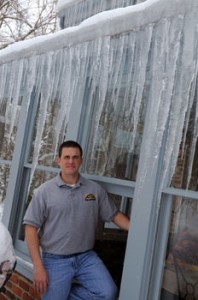With the cold weather and the seemingly endless snow showers, I thought that this would be a good time to once again discuss ice dams, which Legacy Remodeling has been seeing all over Pittsburgh as a result of this January's weather.
 Me Beside an Ice Dam at My Home
Me Beside an Ice Dam at My Home
Ice dams begin to form when cold temperatures and precipitation combine to create a build up of ice in gutters. This frozen gutter prevents water from leaving your roof via the downspout and so instead it begins to over flow the gutter and form icicles. At the same time as the water is freezing down from the gutter, it can also begin to work its way back up your roof.
The growth of this ice can be caused by ongoing snow/freezing rain or can simply be fed by snow that melts higher up on the roof and then runs down to the ice dam and refreezes. In either event, an ice dam can grow up your roof from the gutter, lifting and damaging shingles along the way. In most cases, the ice will eventually reach a point where it is over a heated area and will not be able to continue to freeze. Unfortunately by the time the ice reaches this point, it often has compromised the effectiveness of the roof. At this point the ice dam will effectively become a barrier which prevents water from being able to drain off the roof properly and instead helps to keep it focused on a potential leak.
The threat that ice dams pose to your Pittsburgh home is why good roofers will use a product called ice and water guard on a roof. This rubber membrane underlays the shingles and seals itself to the wood surface of the roof providing a weather barrier even if the shingles are compromised. Applied properly the ice and water guard should run at least 36" up from the roof's edge so that it cover's parts of the roof that are not over heated area's such as on eaves and overhangs. In this way, even if ice does form over unheated area's, it cannot do damage because there is no leak.
When installing a new roof, proper use of an ice and water guard is an important consideration to maximize the weather proofing of your home. Unfortunately for people who are looking at 3 foot icicles and a wet ceiling right now, this information does little good.
At this point your best bet is to minimize the amount of snow on your roof to reduce the melt water that can leak into your home. If you can remove snow from your roof safely via a window or other means (do not go onto an icy roof or try to do this from a ladder) that can help significantly. You can also help the situation if you are able to get heat to a previously unheated area. For example on my home, I have a sunroom that I do not heat in the winter. Unfortunately I had significant water leaking into it last winter due to the heavy ice that had formed on my roof. This year, I have kept the heat on in the sunroom in order to prevent an ice dam from being able to form. So far, so good.
Subscribe to Legacy Remodeling's Blog






Comments